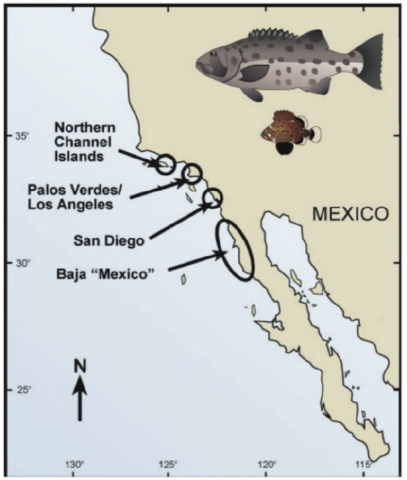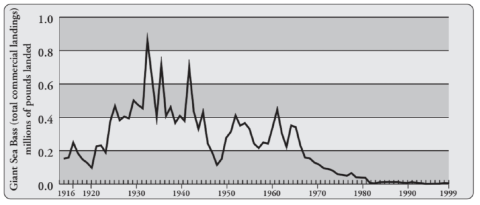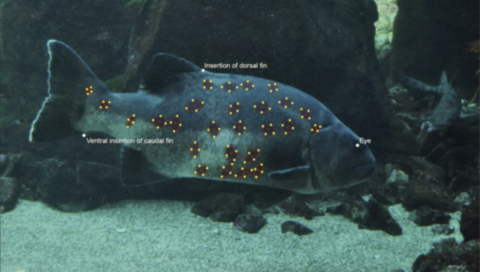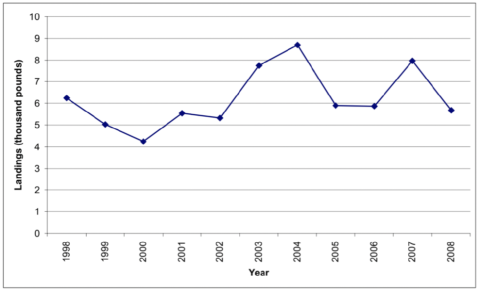Introduction
The giant sea bass (Stereolepis gigas) is the largest bony fish1 found along the California coast and near offshore islands (Balwin et al., 2008). This apex predator has been located in ranges from Humboldt Bay to the southern tip of Baja California, Mexico; however, they are primarily found south of Point Conception, in areas such as La Jolla, Santa Catalina Island, and Anacapa Island (Figure 1). Adult giant sea bass reside on the shallow rocky reefs near kelp beds, ledges, and drop-offs at depths of 11 to 50 meters (Baldwin et al., 2008), while juveniles inhabit both kelp bed areas and sandy bottoms (Gaffney et al., 2007). This slow-growing, long-living species reaches lengths of more than 7 feet (2.3 meters) with a maximum recorded weight of 562 pounds (255 kilograms) (Clevenstine & Lowe, 2021). It usually takes 6 years for giant sea bass to reach 30 pounds (14 kilograms), 10 years to reach 100 pounds (45 kilograms), and up to 15 years to reach 150 pounds (68 kilograms) (Baldwin et al., 2008). It is estimated that they reach maturity at 11 to 13 years old (Allen & Andrews, 2012).

Figure 1: Popular geographical locations of giant sea bass aggregations south of Point Conception. Map source: Chabot et al., 2015.
Due to their slow-growing nature, this species is very susceptible to overfishing as their population growth rate is not able to rapidly replenish lost individuals. In 1870, the commercial fishing of giant sea bass began in southern California, with U.S. commercial landings peaking in 1932 at nearly 200,000 pounds before declining. In Mexico, commercial landings peaked above 800,000 pounds in the same year; however, by 1964 it rapidly declined after peaking below 200,000 (Figure 2; Domeier, 2001). From 1932 to 1980, the giant sea bass population in California and Mexico dropped approximately 95% to 98% (Clevenstine & Lowe, 2021).

Figure 2: Commercial landings of giant sea bass from 1916 to 1999. Data reflects California and Mexican waters landed in California. Graph source: Domeier, 2001.
Aside from giant sea bass being susceptible to overfishing, they are also subject to incidental catch. Although only a few fishermen used a hook-and-target line to target giant sea bass, the species was primarily caught incidentally by gillnets intended for halibut and white sea bass (Domeier, 2001). Unfortunately, it is difficult for most recreational anglers to release giant sea bass back into the water unharmed, as these large fish tend to experience overexpansion trauma to their gas bladder when brought to the surface (Ugoretz, 2002). A few boats had started a special recreational fishery targeting giant sea bass spawning aggregations during the summer months; one three-day trip harvested 255 giant sea bass (Domeier, 2001). However, the fishery collapsed after these aggregations were fully exploited (Domeier, 2001). The recreational fishery of giant sea bass peaked in 1964 in California and in 1973 throughout Mexico (Baldwin et al., 2008).
Regulations
As the giant sea bass population became severely depleted due to the continuing decline of mature individuals, regulatory laws were passed in the U.S. In 1982, the California State Legislature banned all commercial fishing of giant sea bass from California waters (Allen & Andrews, 2012). That same year, the California Fish and Game Commission banned recreational fishing and only allowed anglers to capture two fish per trip from Mexican water; yet, this law still allowed a vessel to land up to 1,000 pounds of Mexican giant sea bass per trip not to exceed 3,000 pounds per year (Domeier, 2001). This law was amended in 1988, in which only one fish from incidental capture could be brought in from California waters (Domeier, 2001).
By 1994, there was increased protection for the giant sea bass as gillnetting and trammel netting were banned in the Southern California Bight, which is within three miles of mainland California and one mile off the islands (Allen & Andrews, 2012). Additionally, the Marine Resources Protection Act implemented fishing depth limits in many mainland counties and around the Channel Islands. It was not until 1996 that the International Union for Conservation of Nature (IUCN) declared the giant sea bass as a red-listed “Critically Endangered” species (Allen & Andrews, 2012). Most recently, the Ocean Resources Enhancement and Hatchery Program’s (OREHP) gillnet monitoring program detected a significant increase in the catch-per-unit effort of giant sea bass from 1995 to 2004 (Baldwin et al., 2008).
Current Research
Within the last decade, there has been a significant increase in giant sea bass research projects. All were formed to learn more about giant sea bass history and geographical data to improve conservation efforts. For instance, the Spotting Giant Sea Bass (SGSB) project is a collaborative community-science effort created and managed by marine scientists in the McCauley Lab and the Love Lab at the University of California, Santa Barbara (SGSB). The project was formed in 2017 and uses pattern-recognition algorithms first developed by astrophysicists to spot patterns in star constellations and was later used by NASA on the Hubble Space Telescope (Cohen, 2018). Giant sea bass images are submitted to the project’s website with information regarding where and when the individual was sighted (SGSB). The unique spot pattern of each individual fish is matched to previously marked or identified giant sea bass in the database (Figure 3). Such fish identifications can help answer important research questions, such as, “How far do giant sea bass move, and what is the seasonality of these movements?,” “How is the population changing over time?,” and “How do giant sea bass utilize marine protected areas?” The collection of new data will improve our knowledge of the giant sea bass species as a whole and support the continuation of stewardship improvement efforts. Not only is this data useful for the project and the conservation of the species, but it also encourages divers, fishermen, and ocean lovers to learn more about and appreciate the giant sea bass in our local coastal reef communities (SGSB).

Figure 3. An example of spot annotations on a giant sea bass image submitted by a community diver, with three reference points: eye, dorsal fin, and caudal fin. (Love et al., 2018).
Another ongoing giant sea bass project is conducted by the Scripps Institution of Oceanography at the University of California, San Diego. The study seeks to reassess the species listing using data from both sides of the U.S.-Mexico border as it may be inaccurate. The study incorporates historical and contemporary perspectives of the giant sea bass fishery with its geographical range and research cooperation within the U.S. and Mexico (Hook, 2021). This includes systematically reviewing past literature about giant sea bass, historically reconstructing fishery landings, biologically monitoring the Mexican fishery’s results, and considering the species’ consumptive and non-consumptive economic value on both sides of the border. Analysis of all these elements suggests that the giant sea bass population is likely to be larger than biologists previously believed, especially in Mexican waters; however, this does not mean the species population is no longer at risk. The study recommends that current protections in the U.S. remain active and management regulations should be placed in Mexico to rebuild the population at a faster rate (Hook, 2021). Furthermore, better collaboration and sharing of information between the U.S. and Mexico are needed to accurately assess, manage, and protect the giant sea bass.
In the summer of 2019, CSU Northridge marine biologist Larry Allen, graduate student Emily Ladin, and a team of students attempted to record the sound of spawning giant sea bass. This recording would help fishery biologists to identify when and where the fish spawn, which would be used to advocate for the protection of those areas (Ramos, 2019). In this experiment, one male and two female “teenage” giant sea bass were placed in a tank at the Southern California Marine Institute. An underwater microphone was placed in the tank to capture a clear recording of the courtship noises, which are “snare drum” sounds made when the fish squeezes their ribs with special muscles and the ribs hit the air bladder. To Allen’s surprise, the spawning event produced about 700 giant sea bass “babies,” though he estimated that more than 100,000 eggs were spawned that same night. The Cabrillo Marine Aquarium and the Aquarium of the Pacific agreed to take in the giant sea bass eggs and serve as nurseries to ensure as many eggs hatched and survived as possible. About 700 of the juvenile giant sea bass survived, half of which have already been released into the ocean in 2020 and have been photo documented in the SGSB database for potential re-sightings in the future (Ramos, 2019). Additionally, three juvenile giant sea bass that were released from the Cabrillo Marine Aquarium at Two Harbors via USC Wrigley have also been tagged and spot-mapped in the SGSB database. The giant sea bass parents (released right after the eggs were spawned) and their offspring have been genotyped and tagged to keep track of their growth and habitat locations (Ramos, 2019). Although there have been previous captive breeding efforts, it can be expensive to take care of large fish, especially if there are many of them. It is extremely difficult to breed in an aquarium setting, as they are often unsuccessful due to the low survival rate of larvae: averaging a dozen or so at a time. The Cabrillo Aquarium employed new nursery techniques, which were carefully developed by their animal care team. This has created optimism in giant sea bass captive breeding efforts for the future. The combination of these projects and future research assist in the increase of the giant sea bass’ population.
Proposed Future Conservation Efforts
Over the last two decades, giant sea bass are beginning to return to the kelp forests and rocky reefs they once inhabited. Since current management practices have been successful at increasing the giant sea bass population, regulations should remain in place. However, regulations should remain in place in order to continue eliminating incidental catch-and-release mortality. Although there is a restriction that limits one giant sea bass incidental catch per trip in Mexico, there are still hundreds caught every year; within a decade (1998 to 2008), incidental fishing of giant sea bass ranged from 4238 to 8689 pounds (Figure 4). These relatively high numbers raise the concern that these catches may not all be incidental. For instance, giant sea bass can be bought in fish markets as they are labeled as “incidental catch,” but there is no definite proof that these giant sea bass were not intentionally caught to be sold. Additionally, the public may not realize that this species is critically endangered and just buy the fish at the market. This may also influence them to go out and catch a giant sea bass without realizing the implications, making it even more difficult to regulate than people actually think. A potential solution to this issue may be to increase no-take marine protected areas to known giant sea bass aggregation areas. This would prohibit any commercial or recreational fishing, which would significantly decrease incidental catch-and-release mortality of giant sea bass. Additionally, an increase in public awareness of giant sea bass population status and regulations amongst recreational fishermen and the general public, especially in fish markets, could improve the efficacy of fishing regulations. An even greater solution to incidental catch is implementing commercial and recreational fishing restrictions of the giant sea bass in Mexico. This would be a consequential conservation effort for the species.

Figure 4. Giant sea bass incidental commercial landings from 1998 to 2008. Graph source: Baldwin et. al, 2008.
It is crucial to establish full protection of giant sea bass aggregation sites to help keep the current and future giant sea bass populations increasing. For instance, the two aggregation sites around or near Santa Catalina Island containing the highest abundance of both juvenile and adult giant sea bass are at Little Harbor and The V's, which are currently in unprotected areas where fishing is still allowed (House et al., 2016). Additionally, monitoring these aggregations after baseline estimates may enable temporal tracking of numerical densities, biomass, and population dynamics of the species (House et al., 2016). Furthermore, protecting nursery areas will significantly support the recovery of the giant sea bass populations. Successful nursing areas for giant sea bass are typically characterized as soft sandy benthos inshore of underwater canyon areas (Benseman & Allen, 2018). The sandy benthos contain a high abundance of food which benefits the babies. Unfortunately, it is also replenished using sediment dredged up from submarine canyons purely for human recreational purposes, such as keeping sand-filled beaches. This process may have harmful effects on the successful recruitment of young-of-year giant sea bass (Benseman & Allen, 2018). Furthermore, it may be difficult to locate exact nursery areas as these may fluctuate over time. Nonetheless, increasing marine protected area ranges toward the shore can adequately improve the conservation efforts for giant sea bass and effectively increase their populations.
Since underwater photo-identification techniques used to re-identify giant sea bass individuals have been successful for the Spotting Giant Sea Bass project, it would be very beneficial to expand the project and its location ranges. As of now, the SGSB project has geographical locations and pinpoints in its database ranging from La Jolla to Monterey Bay. It would be advantageous to expand encounter ranges to Mexican waters to collect more giant sea bass images and determine if any have been re-sighted in the U.S. and vice versa. This would increase our understanding of their spatial patterns and travel distances if the image is matched with a previous encounter in California. Since the project obtains most, if not all, images from community divers, not all giant sea bass in those diving locations have been captured into the database yet. In order to improve this, the project may also implement live underwater cameras at popular giant sea bass places, such as Casino Point, Hermosa Artificial Reef, and La Jolla. The project scientists would be able to continually spot-map new individuals through 24/7 recordings just like the live camera at USC Wrigley on Santa Catalina Island––however, it would be quite costly. Regardless of such limitations in conservation efforts, the protection of giant sea bass should be enhanced in nursery and aggregation areas. With the expansion of marine protected areas and the implementation of no-take regulations in these areas, as well as the increase in public awareness of giant sea bass population status and regulations, it will not only significantly reduce incidental catch-and release-mortality of the species but also decrease the amount of giant sea bass in fish markets, encouraging the public to try to fish on their own. Most importantly, it will preserve recruitment with young-of-year and juvenile giant sea bass surviving to adulthood maintaining their population recovery.
References
Allen, L. G., & Andrews, A. H. (2012). Bomb radiocarbon dating and estimated longevity of Giant Sea Bass (Stereolepis gigas). Bulletin, Southern California Academy of Sciences, 111(1), pp. 1–14. https://doi.org/10.3160/0038-3872-111.1.1
Baldwin, D.S., & A. Keiser. 2008. Giant Sea Bass, Stereolepis gigas. Status of the Fisheries Report, Cal. Dept. Fish Game, p. 8
Benseman, S. A., & Allen, L. G. (2018). Distribution and recruitment of young-of-the-year giant sea bass, Stereolepis gigas, off Southern California
Copeia, 106(2), pp. 312–320. https://doi.org/10.1643/ce-18-021
Chabot, C. L., Hawk, H. A., & Allen, L. G. (2015). Low contemporary effective population size detected in the critically endangered Giant Sea Bass, Stereolepis gigas, due to fisheries overexploitation. Fisheries Research, 172, pp. 71–78. https://doi.org/10.1016/j.fishres.2015.06.015
Clevenstine, A. J., & Lowe, C. G. (2021). Aggregation site fidelity and movement patterns of the protected marine predator giant sea bass (Stereolepis gigas). Environmental Biology of Fishes, 104(4), pp. 401–417. https://doi.org/10.1007/s10641-021-01077-9
Cohen, J. (2018). Spotting Giants. The UCSB Current. https://www.news.ucsb.edu/2018/019052/spotting-giants
Domeier, M.L. (2001). Giant sea bass. In: Leet, W.S., Dewees, C.M., Klingbeil, R., and Larson, E. (Eds.), California’s Marine Living Resources: A Status Report (pp.209-211). Agriculture and Natural Resources Communication Services, University of California, Oakland, California.
Gaffney, P. M., Rupnow, J., & Domeier, M. L. (2007). Genetic similarity of disjunct populations of the Giant Sea Bass (Stereolepis gigas). Journal of Fish Biology, 70 (sa), pp. 111–124. https://doi.org/10.1111/j.1095-8649.2007.01393.x
Hook, B. (2021, August 4). New Study holds promise for "Critically endangered" giant sea bass. Scripps Institution of Oceanography. https://scripps.ucsd.edu/news/new-study-holds-promise-critically-endangered-giant-sea-bass
House, P. H., Clark, B. L. F., & Allen, L. G. (2016). The return of the king of the kelp forest: Distribution, abundance, and biomass of giant sea bass (Stereolepis gigas) off Santa Catalina Island, California, 2014-2015. Bulletin, Southern California Academy of Sciences, 115(1), pp. 1–14. https://doi.org/10.3160/soca-115-01-1-14.1
Love, M. S., Seeto, K., Jainese, C., & Nishimoto, M. M. (2018). Spots on sides of Giant Sea Bass (Stereolepis gigas ayres, 1859) are likely unique to each individual. Bulletin, Southern California Academy of Sciences, 117(1), pp. 77–81. https://doi.org/10.3160/soca-117-01-77-81.1
Ramos, C. R. (2019, October 16). Effort to capture mating sound leads to unexpected birth of hundreds of critically endangered Giant Sea Bass. CSUN Today. https://csunshinetoday.csun.edu/media-releases/effort-to-capture-mating-sound -leads-to-unexpected-birth-of-hundreds-of-critically-endangered-giant-sea-bass/
Spotting Giant Sea Bass. https://spottinggiantseabass.msi.ucsb.edu/
Ugoretz, J. (2002). Giant sea bass. In: Final Environmental Document: Marine Protected Areas in NOAA’s Channel Islands National Marine Sanctuary (Vol. II), pp. 15-16.
Acknowledgments
I would like to thank my faculty professor, Dr. Douglas McCauley, for providing me the opportunity to not only learn so much about giant sea bass but also to work for the Spotting Giant Sea Bass project. I have obtained various experiences from the project alone and have developed a connection with this species. I would like to thank Andrew Pettit for his constant feedback and support throughout the writing of this paper. I feel very fortunate to have been able to contribute to research for the Stereolepis gigas, which I honestly believe I would have not been able to do without the help of both of these two mentors. I hope this paper will one day reach the audience who can make a change and implement more conservation regulations for
these gentle giants.
Lastly, I want to thank my parents and friends for their constant love and support. To Holly Roose, my Promise Scholar director, thank you so much for all the advice and opportunities you have provided to me. I do not think I would be where I am today without your ongoing support and guidance. You have always believed in me when I thought I would never be able to double major and graduate on time, let alone be applying to graduate school for a Ph.D. program. The same goes for my parents. Le agradezco a mis padres por todo lo que han hecho por mi. Miles de gracias por siempre apoyarme en todas mis decisiones y estudios. Todo lo que he hecho es para ustedes y espero darles más en el futuro. Esto es solo el comienzo.